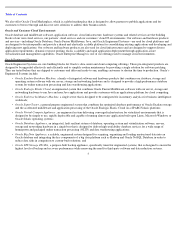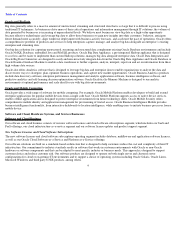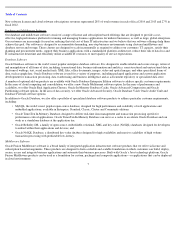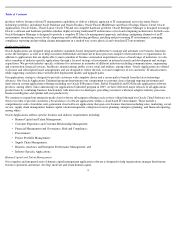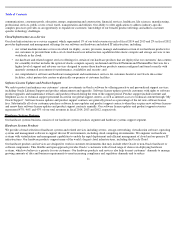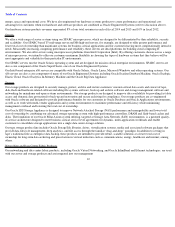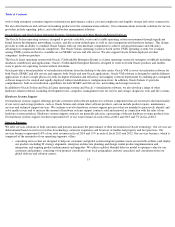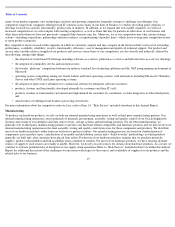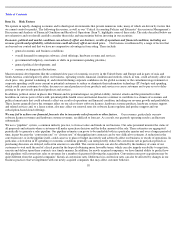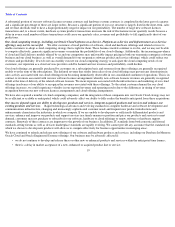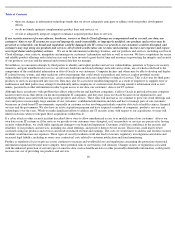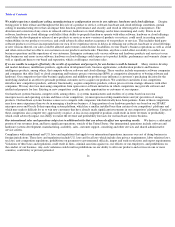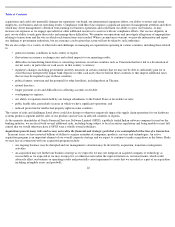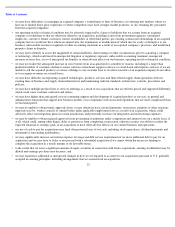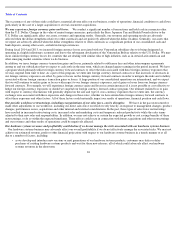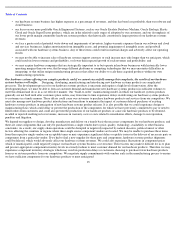Oracle 2013 Annual Report Download - page 19
Download and view the complete annual report
Please find page 19 of the 2013 Oracle annual report below. You can navigate through the pages in the report by either clicking on the pages listed below, or by using the keyword search tool below to find specific information within the annual report.
Table of Contents
many of our market segments, new technologies and new and growing competitors frequently emerge to challenge our offerings. Our
competitors range from companies offering broad IT solutions across many of our lines of business to vendors providing point solutions, or
offerings focused on a specific functionality, product area or industry. In addition, as we expand into new market segments, we will face
increased competition as we will compete with existing competitors, as well as firms that may be partners in other areas of our business and
other firms with whom we have not previously competed like Amazon.com, Inc. Moreover, we or our competitors may take certain strategic
actions—including acquisitions, partnerships and joint ventures, or repositioning of product lines—which invite even greater competition in one
or more product categories.
Key competitive factors in each of the segments in which we currently compete and may compete in the future include: total cost of ownership,
performance, scalability, reliability, security, functionality, efficiency, ease of management and quality of technical support. Our product and
service sales (and the relative strength of our products and services versus those of our competitors) are also directly and indirectly affected by
the following, among other things:
For more information about the competitive risks we face, refer to Item 1A. “Risk Factors” included elsewhere in this Annual Report.
Manufacturing
To produce our hardware products, we rely on both our internal manufacturing operations as well as third party manufacturing partners. Our
internal manufacturing operations consist primarily of materials procurement, assembly, testing and quality control of our Oracle Engineered
Systems and certain of our enterprise and data center servers, storage systems and networking products. For all other manufacturing, we
generally rely on third party manufacturing partners to produce our hardware related components and hardware products and we may involve our
internal manufacturing operations in the final assembly, testing and quality control processes for these components and products. We distribute
most of our hardware products either from our facilities or partner facilities. Our manufacturing processes are based on standardization of
components across product types, centralization of assembly and distribution centers and a “build-to-order” methodology in which products
generally are built only after customers have placed firm orders. Production of our hardware products requires that we purchase materials,
supplies, product subassemblies and full assemblies from a number of vendors. For most of our hardware products, we have existing alternate
sources of supply or such sources are readily available. However, we do rely on sole sources for certain of our hardware products. As a result, we
continue to evaluate potential risks of disruption to our supply chain operations. Refer to “Risk Factors” included in Item 1A within this Annual
Report for additional discussion of the challenges we encounter with respect to the sources and availability of supplies for our products and the
related risks to our business.
15
•
the adoption of cloud based IT offerings including software
-
as
-
a
-
service, platform
-
as
-
a
-
service and infrastructure
-
as
-
a
-
service offerings;
•
the adoption of commodity servers and microprocessors;
•
the broader “platform”
competition between our industry standard Java technology platform and the .NET programming environment of
Microsoft;
•
operating system competition among our Oracle Solaris and Linux operating systems, with alternatives including Microsoft’s Windows
Server, and other UNIX and Linux operating systems;
•
the adoption of open source alternatives to commercial software by enterprise software customers;
•
products, features and functionality developed internally by customers and their IT staff;
•
products, features or functionality customized and implemented for customers by consultants, systems integrators or other third parties;
and
•
attractiveness of offerings from business processing outsourcers.


